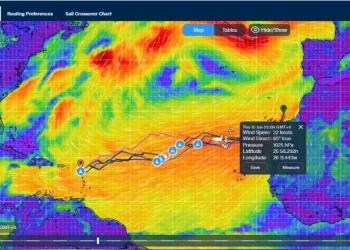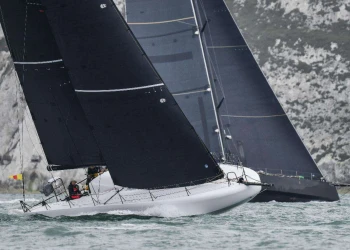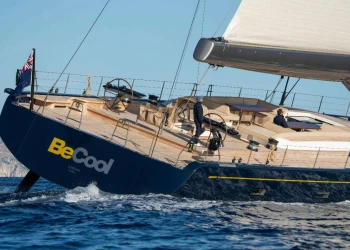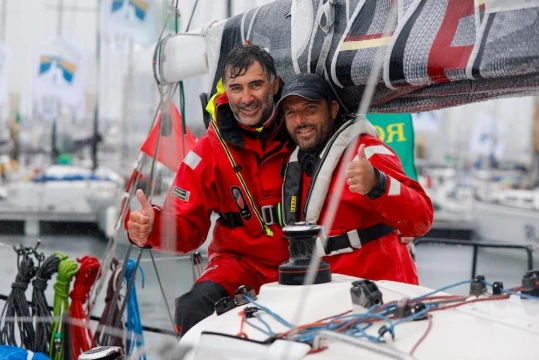
Les P'tits Doudous en Duo finished first in IRC Two-Handed, the JPK 1010 ably co-skippered by Romain Gibon and Alban Mesnil © Paul Wyeth
Rolex Fastnet Race: doublehanded domination
One of the strongest competitions within the Royal Ocean Racing Club’s 50th Rolex Fastnet Race was in the ever-swelling ranks of IRC Two-Handed, mostly populated from IRC Two and IRC Three. This has steadily grown since it was first introduced in 2005 - this year it was up to a record 96, a quantum leap from the 64 that raced in pre-COVID 2019. And this figure doesn’t include the IMOCAs and several Class40s, many competing doublehanded in preparation for this autumn’s Transat Jacques Vabre.
In the early hours of a wet, stormy Thursday, first to finish into Cherbourg in IRC Two-Handed was Lann Ael 3, raced by the 2017 Rolex Fastnet Race’s outright winner Didier Gaudoux and former Figaro sailor Erwan Tabarly (nephew of the late Eric). Launched this April to replace Gaudoux’s previous 39ft Nivelt-designed winner, this special new purpose-built racer was designed to race doublehanded in a special co-operation between Mini/Class40/IMOCA designer Sam Manuard and French yacht design legend Bernard Nivelt. When she finished, Lann Ael 3 topped the leaderboard, but subsequent arrivals dropped her down it.
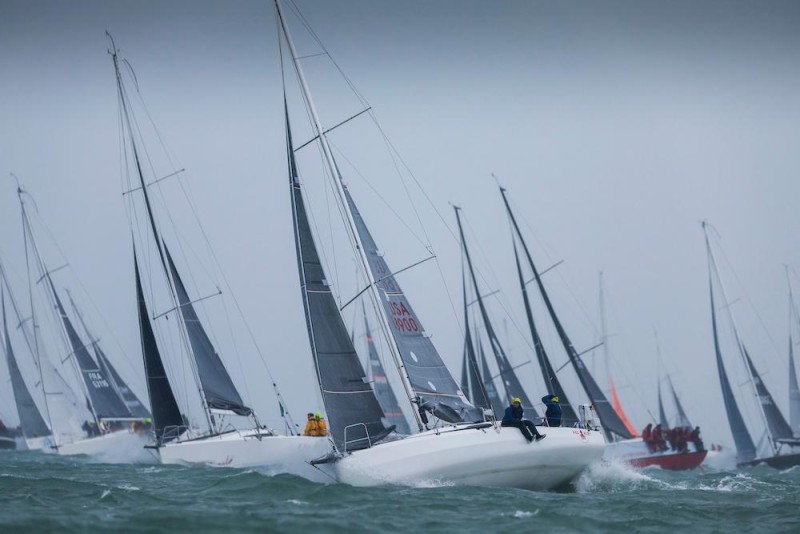
Ultimately in IRC Two-Handed Romain Gibon and Alban Mesnil on Les P’Tits Doudous en Duo prevailed, also winning IRC Three in the process. This double win continued the tradition begun by Cherbourg-based father and son Pascal and Alexis Loison on their JPK 1010 Night And Day, who not only won both classes but also became the first and, to date, only, doublehanded overall winners of the Rolex Fastnet Race in 2013. They won IRC Two-Handed and Three again in 2017, Figaro sailor son Alexis going on to repeat this with ‘Mr JPK’ Jean-Pierre Kelbert in the latter’s JPK 1030 Léon in both 2019 and then again with Guillaume Pirouelle in 2021.
This year’s IRC Two-Handed victors were from Le Havre, like the 2023 IRC One winners on Pintia. However unlike Alexis Loison, Gibon and Mesnil are amateur sailors (Gibon is an engineer, Mesnil works in insurance) albeit highly experienced and heavily trained. For example when they acquired their JPK 1010 they already had the full measure of it having raced extensively on Noel Racine’s previous Foggy Dew. JPK 1010s also have a great track record – it is the third occasion this Jacques Valer-design has won this trophy and the fourth time a JPK has simultaneously lifted both trophies. Inside this year’s IRC Two-Handed top 10, the first, second, fourth and ninth-placed IRC Two-Handed finishers were all JPK 1010s, in addition to the a JPK 1030, J/99, Sun Fast 3200 R2 and three Sun Fast 3300s.
This year the spread of the IRC Two-Handed top ten fell equally across both IRC Two and Three. However such is the dominance today of those racing two-up, that the fully-crewed competitors in these classes have some work to do: This year there were eight doublehanded yachts in the top 10 in IRC Two and seven in IRC Three.
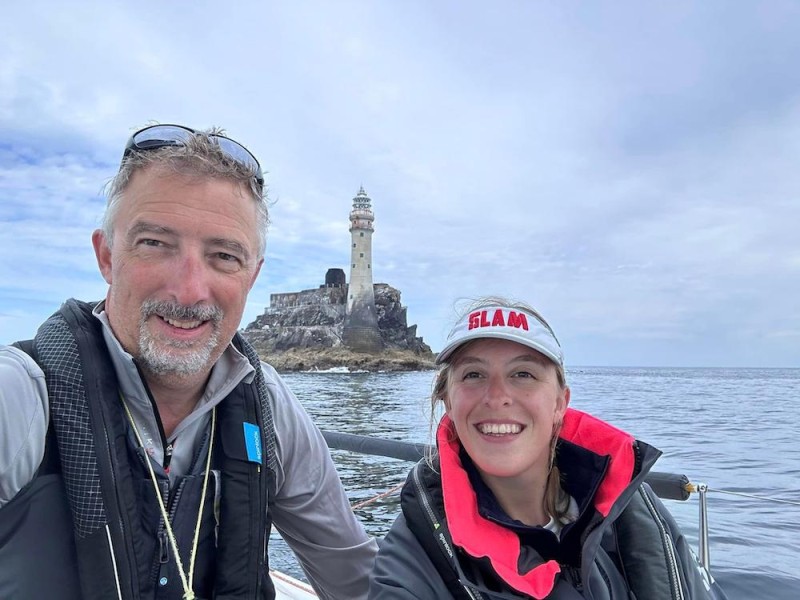
In terms of nationality, France claimed the top five places and ninth, with three British boats in the bottom half of the top 10 and one US boat. (In 2021 six in the top 10 were French and four Brits, while the last British IRC Two-Handed winners were Stuart Childerley and Kelvin Rawlins in 2015 aboard the J/105 Jester).
Even if they were amateurs, who had only raced doublehanding for the past year and a half, Gibon and Mesnil managed to soak up knowledge from France’s many pro shorthanded sailors, notably Alexis Loison. Among the lessons was knowing when to push, but also how to make sail changes as efficiently as possible. This proved vital on the final night when, as they were negotiating this race’s third front, they blew up two spinnakers, forcing them to revert to their genoa.
Putting in a top performance this year were Seattle-based husband and wife duo Chris and Justin Wolfe on their Sun Fast 3300 Red Ruby. “We come here because there are 100 boats on the start line that are pretty similar,” explains Justin. “We have raced with 100 boats doublehanded at home, but very rarely and the range is a Folkboat to a TP52. Here we were looking at 10 competitors on the water for the entire race. There were 21 other Sun Fast 3300s racing. There is nowhere else in the world you can get that.”
While the sport takes place on a smaller scale in the Pacific northwest, it has been around for longer - the Wolfes have been doublehanding now for 28 years.
The Wolfes visited the UK to take part in some qualifiers prior to the Rolex Fastnet Race, but these took place in 8-12 knots and so were hardly good preparation for 40+ knots. “We had zero experience in this boat in those conditions,” admitted Justin.
“The first one was hard, but we knew it was coming. We were prepared for it and we had the boat set up before the start for it. The second one going up to the Fastnet Rock was the hardest one, because it was really long and we didn’t really plan for that. And it was upwind, which is not the strength of our kind of scow boat.”
In their race, they managed to save the ‘best’ until last, blasting down the Channel towards the finish: “25 knots, gusting 30, jib reaching in pitch black with the autopilot - we couldn’t see the bow of the boat. It was SO dark, there was nothing to differentiate the water from the sky. We were looking on AIS and there were competitors right next to us and we never knew they were there. Just ahead a tanker was going up the Channel…and we were catching it! It was VERY fast. We did at least 230 miles in the last 24 hours.” Red Ruby ended up seventh in IRC Two-Handed.
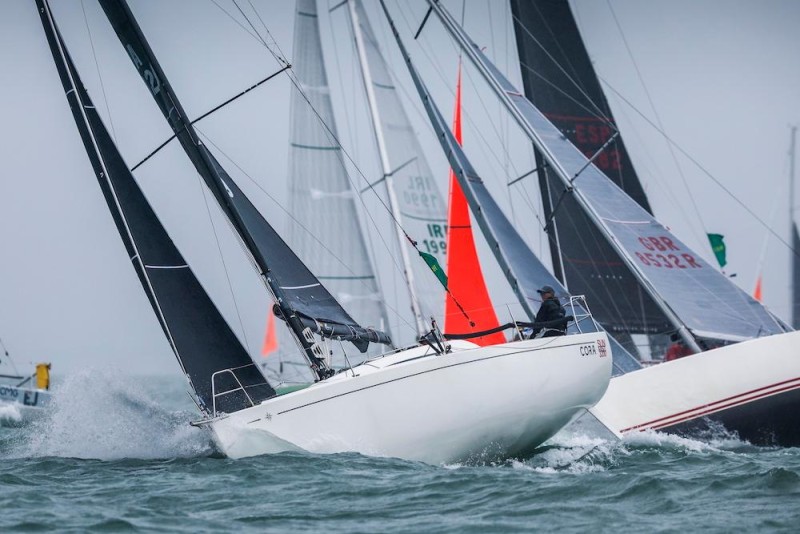
Aside from the duration they have been doublehanding, they have benefitted from some coaching from McKee. “We really share. We switch over driving, very frequently,” says Justin. Chris adds: “Justin does a lot of the navigation. We used to race triathlons so are used to managing the endurance and the concentration, so we switch over quickly if someone needs a break.” While husband and wife doublehanders are a rarity in the UK, there are some high profile examples on the US West Coast, including Stan and Sally Honey and Bill and Melinda Erkelens. “We have fun doing it. I actually have no interest in racing with someone else,” says Justin.
Bellino’s Rob Craigie and Deb Fish are one of the longest serving doublehanders on the UK circuit, both with lengthy experience of the Rolex Fastnet Race (for Fish this was her 11th). This year their priority was getting through the first 12 hours unscathed, after they were put out of the 2021 race when they were hit by a port tack boat. So, says Fish:
“We started with two reefs and No.4 jib and even though the port end was massively favoured, we started a little way north to keep out of the melee. And we took the North Channel just to avoid the Bridge. That first night - it churned - wind over tide, it was a bad sea state for sure. We saw gusts over 40 knots. It is the roughest Fastnet I’ve ever done.”
The violent seastate took its toll on Fish and even affected Craigie, the hardened seadog: “I was feeling rough for the first 24 hours - which was unusual for me.”
As with so many, they treated the opening hours as survival until the front had passed and conditions abated. But in the big conditions they did all they could to preserve Bellino, avoiding the tidal races off the headlands, for example.
“Slamming just damages boats,” says Fish. “Even if you don’t lose your mast, you do all sorts of little bits of damage. The fire extinguishers broke away. The electronics were playing up all race.”
Craigie continues: “I started disconnecting things and they started to work better. Then it stopped raining and 12 hours later everything was fine! Then it started raining again and after about three hours the pilot stopped working and all the numbers disappeared again!” Their ‘fair weather’ autopilot meant that they ended up hand steering, which meant that whenever they were just one-up on deck, they were unable to trim effectively.
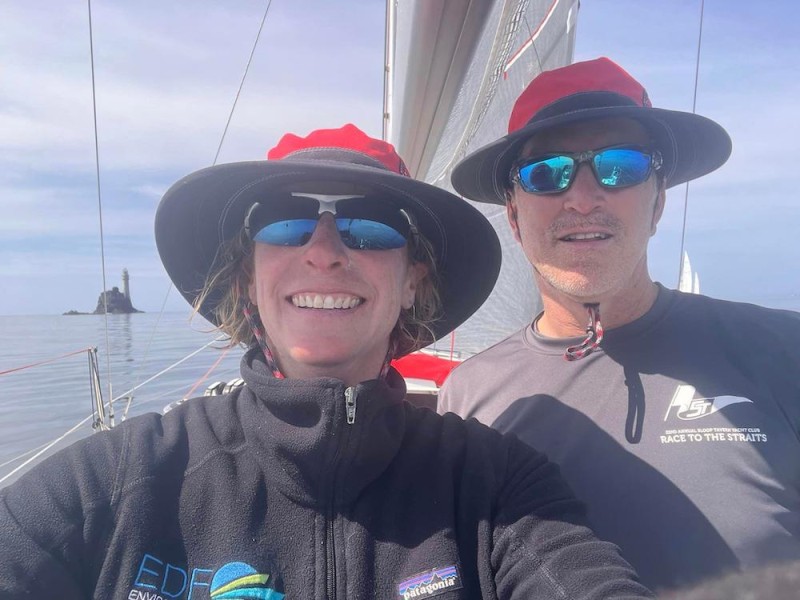
They made up ground on the boats ahead when the trough passed overall and then did well choosing the usually unfavoured route up the east side of the Land’s End TSS where the wind built and shifted, enabling them to more or less lay the Rock. “Red Ruby gained a lot there by just going deep and fast and were nearer the Rock when the wind changed. We just got pinned and couldn’t ease the sheets,” recalls Fish.
Their Rock rounding was special, Craigie remembers: “That was the nicest part of the race. It was warm. There wasn’t a lot of wind. You could see the sun over the mountains of Ireland. I was thinking that would be a nice place to stop!”
Again the big speeds came en route to the finish when Bellino hit 22 knots passing Cap de la Hague in 30 knots. “I couldn’t see the speedo because there was so much water in my face,” said Fish, concluding: “In our group, those who have won have sailed brilliantly because you had to sail upwind in strong winds, which is challenging, and keep the kite up in strong winds, which is challenging, and keep going in not a lot of wind.” Bellino finished 18th in IRC Two-Handed.
The 2022 RORC Yacht of the Year the JPK 1010 Jangada came home 25th, owner Richard Palmer enjoying sailing with his daughter Sophie. He remembers the most brutal conditions of the 2007 race, the start of which was delayed by 25 hours but still resulted in two thirds of the fleet retiring. Then just two doublehanded boats finished. This year in IRC Two-Handed there were three DNS and 46 retirements – ie half of the fleet finished.
Given Jangada’s extensive racing programme, racing in 40+ knots was nothing new to Palmer and his daughter Sophie had previously experienced this in the Azores and Back Race. “We made the conscious decision to switch back to our old main which has three reefs in it, so we were able to change gears. At the start we had J4 and two reefs. By the time we got to Hurst we put the third reef in and we came out through the North Channel with a boat fully in control.”
During the race, Richard says he and Sophie adapted their three hour watch system, dropping it to 2.5 hours. “With two-handed racing you have got to find the balance that works for both of you and adjust accordingly.” Jangada also suffered pilot problems although Richard admits he likes to steer in waves. Being smaller, they saw the full brunt of all three weather systems that passed through.
Of the doublehanded scene in the UK, Richard observes:
“It is growing in popularity and the standard across the fleet is increasing, but we have to put the miles in. They [the French] put in a huge amount of time and not all racing too - just getting out there practicing and training and working on boat-on-boat development.”



